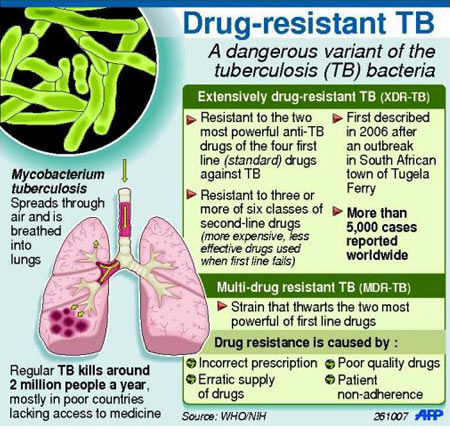While Iran first reported TDRTB cases three years ago, India seems to be only the second country to report this deadly form of the disease. TDR-TB is the result of the latest mutation of the bacilli after Multi-Drug-Resistant TB (MDR-TB ) and Extremely Drug-Resistant TB (XDR-TB ) were diagnozed earlier.
Even more worryingly for Mumbai, 10 of the 12 TDR-TB cases are from the city, while the other two are patients from Ratnagiri and UP. One of the 12 patients has since died. India sees around 3- 4 lakh deaths for all forms of TB each year, while the world saw 1.7 million deaths in 2009.
As the full form of TDR-TB suggests, none of the known TB combination drugs work on the patient. All 12 showed resistance to 12 drugs. "The TB bacilli have obviously mutated. The emergence of TDR-TB has grave implications for public health," said Hinduja Hospital's Dr Zarir Udwadia, whose observations have been published in the latest issue of the US-based Clinical Infectious Diseases (CID) peer review journal. His team started isolating TDR-TB cases among patients with pulmonary TB in October 2011.
Dr Amita Athawale, who heads KEM Hospital's chest department, said TDR-TB was a reality in India. "The cases we clinically isolate are just the tip of the iceberg," she said. TB is one of the biggest killers in India, along with heart attack.
Among tuberculosis patients, drug resistance develops mainly because patients fail to complete the 6- to 9-month first treatment phase. "They feel better within a couple of months of taking the drugs and so they stop taking them. However, the TB germs in the body are not completely vanquished and they again multiply," said a senior BMC public health official.
Virulent Strain in the Air
- Tuberculosis is one of the most fatal diseases in Mumbai, accounting for nearly 15% (8,953) of the deaths in 2010
- Left untreated, each person with active TB can infect 10 to 15 people a year TB is a contagious disease. Like the common cold, it spreads through the air Patients resistant to all first-line and second-line drugs are classified as having Totally Drug-Resistant TB (TDR-TB )
- An estimated 1.7 million people died from TB worldwide in 2009
- About 3 lakh to 4 lakh die of TB each year in India It is believed that more than half the city's TB patients seek treatment in the private sector
From the emergence of Multi-Drug-Resistant tuberculosis (MDR-TB ) in 1992 to the arrival of Extremely Drug-Resistant TB (XDR-TB ) a few years ago, the TB bacilli have now reached a totally resistant form. The new, deadlier form is Totally Drug-Resistant TB (TDR-TB ). "A hundred years ago, TB patients were sent to the sanatorium for treatment. With the emergence of these various drug-resistant strains, we have come full circle to the idea for sanatoria. We have little to offer these patients except for drastic surgery and medication for some relief,'' said Dr Zarir Udwadia, of Hinduja Hospital , Mahim. His team's observations have been published in the latest issue of the USbased Clinical Infectious Diseases (CID) peer review journal.
Udwadia says the emergence of TDR-TB is the failure of the overall health system. "The public sector only provides second-line drugs to 1% of the patients who have drug-resistant TB. The private sector has many doctors who badly manage patients. These factors have obviously worsened drug resistance." An earlier study by the group showed that barely 5 of 106 doctors in Dharavi prescribed the right drugs for drug-resistant patients.
The CID report, written by Udwadia , Rohit Amale and Camilla Rodrigues of Hinduja Hospital says, "A careful audit of their (patients) prescriptions revealed that these patients had received erratic, unsupervised second-line drugs, added individually and often in incorrect doses, from multiple private practitioners."
TDR-TB was reported three years ago in Teheran, the Iranian capital, when 15 patients were found to have bacilli resistant to all first- and second-line drugs. A worrisome aspect of the Hinduja Hospital findings is that the average age of the 12 patients - six men and six women - is just 32.3 years.
While the minimum period of suffering has been two years, one patient (who cannot be named due to confidentiality clauses) is the 35-year-old wife of a farmer from Deveria, UP. She has been ill for over five years. While the patient is very ill, her husband told TOI, "We began treatment in a local hospital for a year before moving to Lucknow and then Kanpur for treatment.'' She has been on an MDR-TB drug regimen for over two years. "I have sold major portions of my farm in this period and have taken up work in Mumbai,'' he added.
Hinduja Hospital doctors are awaiting a CT scan before deciding whether a lung surgery can provide some relief to the woman.




Reader Comments
to our Newsletter